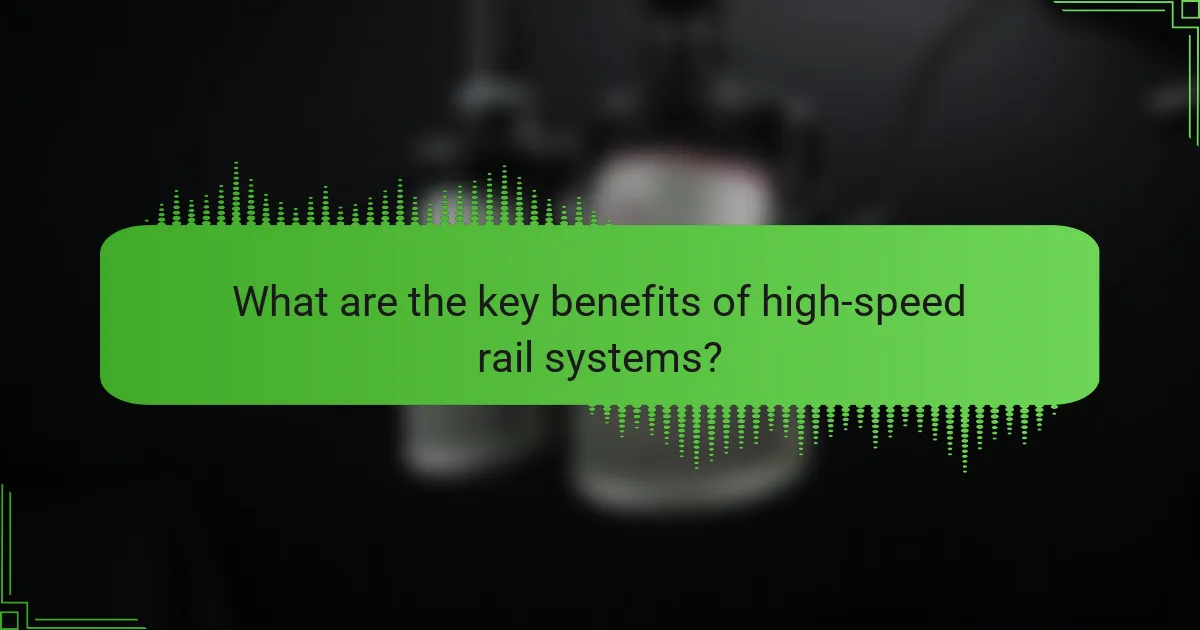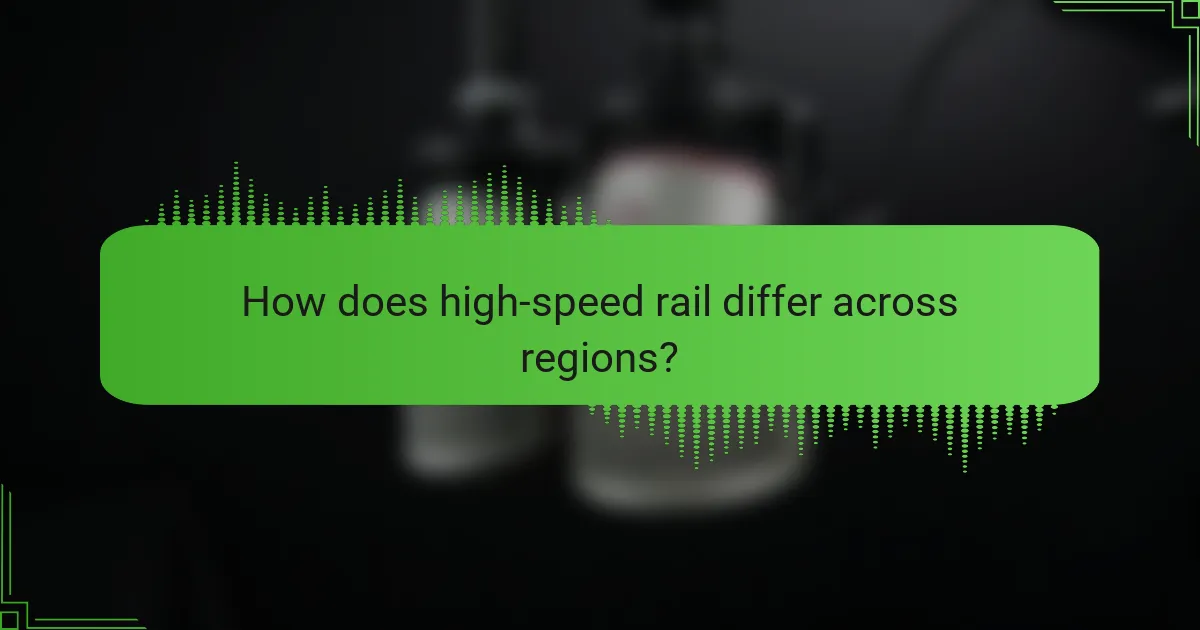High-speed rail systems significantly reduce travel time and enhance economic growth while promoting environmental sustainability. However, these projects face challenges such as funding, regulatory hurdles, and public acceptance. Global trends show increased investment and technological advancements, with varying service models across regions. Successful implementations often integrate with existing networks and prioritise sustainability.

What are the key benefits of high-speed rail systems?
High-speed rail systems offer significant benefits, including reduced travel time, increased energy efficiency, and enhanced economic growth. These systems can cut travel times between major cities, making them more accessible. They also produce lower emissions compared to cars and planes, contributing to environmental sustainability. Additionally, high-speed rail fosters regional development by connecting urban and rural areas, boosting local economies.
How does high-speed rail reduce travel time compared to traditional rail?
High-speed rail significantly reduces travel time compared to traditional rail by operating at speeds often exceeding 300 km/h. This efficiency is achieved through dedicated tracks, advanced train technology, and streamlined operations. For example, a journey that takes several hours on conventional trains can be completed in under two hours on high-speed rail. Additionally, high-speed rail systems minimise stops and optimise schedules, further enhancing travel efficiency.
What environmental advantages does high-speed rail offer?
High-speed rail offers significant environmental advantages, including reduced greenhouse gas emissions and lower energy consumption. Compared to cars and airplanes, trains produce fewer emissions per passenger mile. Additionally, high-speed rail systems often encourage urban development around stations, promoting sustainable land use. This mode of transport also alleviates road congestion, leading to decreased air pollution in urban areas. By integrating renewable energy sources, high-speed rail further enhances its eco-friendliness, contributing to a greener transportation infrastructure.
How does high-speed rail contribute to economic growth?
High-speed rail significantly boosts economic growth by enhancing connectivity, reducing travel time, and fostering regional development. It stimulates job creation, increases productivity, and attracts investments. For instance, studies show that regions served by high-speed rail experience a 15-20% increase in economic activity. Furthermore, the environmental benefits of reduced congestion and lower emissions contribute to sustainable growth.
Which social impacts can be observed from high-speed rail implementation?
High-speed rail implementation leads to significant social impacts, including enhanced connectivity and economic growth. Improved access to urban centres fosters job creation and boosts local businesses. Additionally, high-speed rail promotes environmental sustainability by reducing reliance on cars and planes, resulting in lower carbon emissions. Social equity is also advanced, as it provides affordable transportation options for underserved communities.

What challenges do high-speed rail projects face?
High-speed rail projects face significant challenges including funding, land acquisition, regulatory hurdles, and public acceptance. These obstacles can delay timelines and increase costs. For example, securing financing for large-scale infrastructure often requires navigating complex political landscapes. Additionally, land acquisition can provoke opposition from communities, complicating project development. Regulatory hurdles may include lengthy approval processes, which can stall progress. Public acceptance is critical; projects often require strong advocacy to gain community support.
How do funding and investment affect high-speed rail development?
Funding and investment significantly impact high-speed rail development by determining project feasibility and scope. Adequate financial backing enables advanced technology, infrastructure improvements, and operational efficiency. For instance, countries like Japan and France have successfully leveraged public and private investments to enhance their rail networks. A study showed that every dollar invested in high-speed rail can generate up to four dollars in economic returns, emphasizing the importance of financial resources in achieving sustainable transport solutions.
What are the technical challenges in building high-speed rail networks?
Building high-speed rail networks faces several technical challenges. Key issues include the high costs of infrastructure, complex land acquisition processes, and the need for advanced technology to ensure safety and efficiency.
Additionally, integrating high-speed rail with existing transportation systems poses logistical difficulties. Environmental concerns, such as noise pollution and land use, also complicate planning and construction.
Lastly, maintaining high-speed trains requires specialised maintenance facilities and skilled personnel, which can be a rare attribute in some regions. These challenges must be carefully managed to realise the benefits of high-speed rail.
How do regulatory and political factors influence high-speed rail projects?
Regulatory and political factors significantly influence high-speed rail projects by shaping funding, safety standards, and land use policies. Government support often dictates project viability and public acceptance. For instance, favourable regulations can expedite approvals, while political opposition may delay or halt initiatives.
Internationally, countries like Japan and France showcase how strong government backing fosters successful high-speed rail systems. Conversely, in the U.S., fragmented political support has led to inconsistent progress.
Funding mechanisms also vary, with public-private partnerships emerging as a popular model. This approach can mitigate financial risks and attract investment, but it requires clear regulatory frameworks to ensure accountability and efficiency.
Ultimately, the interplay between regulatory frameworks and political will is crucial for the successful implementation of high-speed rail projects.

What global trends are shaping the future of high-speed rail?
Global trends shaping the future of high-speed rail include increased investment in infrastructure, advancements in technology, and a growing emphasis on sustainability. Countries are prioritising connectivity to enhance economic growth and reduce travel times. For instance, the European Union aims to expand its rail network to meet climate targets. Innovations like magnetic levitation and electrification are improving efficiency and reducing emissions. Additionally, public demand for faster, reliable transport options is driving governments to invest in high-speed rail projects.
Which countries are leading in high-speed rail adoption and innovation?
China, Japan, and France are leading in high-speed rail adoption and innovation. China boasts the largest network, with speeds exceeding 350 km/h, while Japan is renowned for its Shinkansen system, emphasising punctuality and safety. France’s TGV has set benchmarks in speed and efficiency, influencing global standards. These countries showcase advancements in technology, infrastructure, and passenger experience, driving the future of rail travel.
How is technology advancing high-speed rail systems?
Technology is significantly advancing high-speed rail systems through innovations in infrastructure, energy efficiency, and automation. Enhanced train control systems improve safety and reliability, while lightweight materials reduce energy consumption. Developments in magnetic levitation technology allow for faster travel speeds, with some trains reaching over 400 km/h. Additionally, smart technology integration optimises scheduling and maintenance, enhancing overall performance. These advancements position high-speed rail as a sustainable and efficient transportation option globally.
What role does public opinion play in high-speed rail expansion?
Public opinion significantly influences high-speed rail expansion by shaping political decisions, funding allocations, and public support. Positive public sentiment can lead to increased investment and faster project approvals. Conversely, opposition can delay or halt initiatives. Engaging communities through transparent communication and addressing concerns fosters support. For example, successful high-speed rail projects often include public consultations to gauge opinions and adapt plans accordingly.

How does high-speed rail differ across regions?
High-speed rail varies significantly across regions due to infrastructure, technology, and service models. In Europe, high-speed trains like the TGV in France prioritise speed and connectivity, achieving speeds up to 320 km/h. In contrast, Japan’s Shinkansen emphasises punctuality and safety, with an average speed of 240 km/h and a unique earthquake detection system. China leads in network size, operating over 38,000 kilometres of high-speed rail, while the United States has limited high-speed options, focusing on regional connectivity rather than speed. These differences reflect regional priorities, investment levels, and technological advancements.
What unique features characterize high-speed rail in Asia?
High-speed rail in Asia is characterised by advanced technology, extensive networks, and high passenger capacity. These features enable rapid transit between major cities, significantly reducing travel times. For instance, Japan’s Shinkansen operates at speeds up to 320 km/h, while China’s network boasts trains reaching 350 km/h. Unique attributes include dedicated tracks that minimise delays and a focus on energy efficiency. Additionally, the integration of high-speed rail with urban transit systems enhances accessibility and convenience for travellers.
How does the European high-speed rail system compare to others?
The European high-speed rail system is among the most advanced globally, known for its extensive network and efficiency. It boasts speeds of up to 300 km/h, significantly reducing travel times between major cities. In comparison, high-speed rail systems in Asia, such as Japan’s Shinkansen, also achieve similar speeds but have different operational models and cultural integration.
Europe’s high-speed rail benefits from well-established infrastructure and government support. Countries like France, Spain, and Germany have invested heavily in their networks, resulting in seamless connections across borders. In contrast, the United States has limited high-speed rail development, focusing instead on conventional rail systems.
A unique attribute of the European system is its emphasis on sustainability, with many trains powered by renewable energy sources. This contrasts with high-speed rail in other regions, which may rely more on fossil fuels.
Overall, the European high-speed rail system sets a benchmark for efficiency and environmental consciousness, influencing global trends in rail transportation.
What are the emerging trends in high-speed rail in North America?
Emerging trends in high-speed rail in North America include increased investment, technological advancements, and environmental sustainability. Several states are prioritising high-speed rail projects to enhance connectivity and reduce traffic congestion. For instance, California’s high-speed rail initiative aims to connect major cities, promoting economic growth. Additionally, new technologies like magnetic levitation are being explored to improve speed and efficiency. Environmental considerations are driving a shift towards greener rail options, aligning with sustainability goals.

What are some rare attributes of successful high-speed rail projects?
Successful high-speed rail projects often feature rare attributes that enhance their effectiveness. These include seamless integration with existing transportation networks, innovative financing models, and strong public-private partnerships. Additionally, projects that prioritise environmental sustainability through energy-efficient technologies stand out. Another unique aspect is the ability to adapt to regional cultural and economic contexts, ensuring local support and utilisation. Lastly, advanced safety measures and real-time monitoring systems contribute to operational excellence and passenger confidence.
Which innovative financing models have been used in high-speed rail?
Innovative financing models for high-speed rail include public-private partnerships, government grants, and bond financing. These approaches leverage private investment while minimising public risk. Public-private partnerships, for instance, have proven effective in countries like Spain, where collaboration has accelerated project delivery and reduced costs. As a result, these models facilitate the development of extensive high-speed rail networks globally.
How do cultural factors influence the design of high-speed rail systems?
Cultural factors significantly shape high-speed rail system design. These factors influence aesthetics, functionality, and user experience.
Cultural preferences dictate station designs, impacting architectural styles and materials used. For instance, Japan emphasises minimalism and harmony with nature, while France showcases grandeur and historical elements.
User behaviour varies by culture, affecting seating arrangements and service models. In some regions, communal spaces are prioritised, while others may focus on privacy.
Cultural attitudes towards technology and sustainability also affect the adoption of high-speed rail. Countries with strong environmental values may integrate green technologies more prominently.
What lessons can be learned from high-speed rail failures?
High-speed rail failures provide critical lessons for future projects. Poor planning, inadequate funding, and lack of public support often lead to setbacks. For instance, the California high-speed rail project faced delays and budget overruns due to unrealistic timelines and political challenges. Additionally, integrating high-speed rail with existing transportation systems is essential for success. Projects must prioritise stakeholder engagement and thorough feasibility studies to mitigate risks. Lastly, learning from international examples, such as Spain’s successful network expansion, can guide future endeavours in optimising efficiency and user experience.
What best practices should be followed for successful high-speed rail implementation?
Successful high-speed rail implementation requires strategic planning, stakeholder engagement, and robust funding. Prioritise comprehensive feasibility studies to assess demand and route viability. Engage with local communities to address concerns and ensure public support. Secure diverse funding sources, including government grants and private investments, to cover high initial costs. Implement advanced technology for safety and efficiency, while maintaining a focus on environmental sustainability. Regularly monitor and evaluate performance to adapt to changing needs and enhance service quality.


